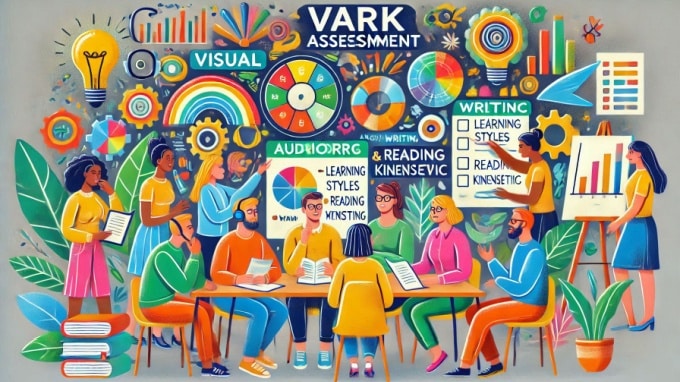Maximise Learning with the VARK Assessment
The VARK assessment, a globally recognised tool, empowers you to uncover your unique learning preferences. At Self Help School, we offer a wide range of resources for personal development and continuing professional development (CPD).
The VARK assessment is a valuable, free resource that can help you maximise the benefits of these tools by showing you how to best align them with your learning style.
Ready to dive into the world of VARK and discover how it can reshape the way you learn and grow? Let’s explore further, or you can take the FREE VARK Learning Styles Assessment now!
What Is the VARK Assessment?
VARK stands for Visual, Auditory, Reading/Writing, and Kinaesthetic. These are the four primary learning styles identified by Neil Fleming, the creator of the assessment.
Rather than assuming everyone learns the same way, VARK highlights how individuals absorb, process, and retain information most effectively.
Visual learners thrive on diagrams, charts, and colour-coded notes. Auditory learners benefit from discussions, lectures, and sound-based resources.
Those who prefer reading and writing often excel with text-heavy materials, while kinaesthetic learners engage best through hands-on experiences and physical activities.
This diversity in learning styles explains why some people flourish in lecture halls, while others excel in workshops or interactive settings.
The VARK assessment is more than a personality quiz; it’s a roadmap to optimising your learning strategy and making the most of the resources available at Self Help School.

How to Take the VARK Assessment
Taking the VARK assessment is straightforward. It’s designed to pinpoint your preferred learning modalities. Once you answer a series of situational questions, your results reveal whether you favour one style or a blend of several.
For example, you might discover you’re a “multimodal learner,” meaning you integrate two or more learning styles. This is a common outcome and demonstrates how versatile the tool can be.
The detailed report provided post-assessment includes actionable tips tailored to your preferences, helping you implement changes immediately.
Applying VARK Insights in Everyday Life
Knowing your learning style is just the beginning. Once armed with your VARK profile, you can apply it to diverse areas of life. Let’s start with personal development.
If you’re a visual learner, watching tutorials or creating vision boards can turbocharge your progress. Auditory learners might thrive with podcasts or guided meditations.
In professional contexts, VARK can revolutionise communication. Team leaders who understand their members’ preferences can structure meetings, presentations, and training sessions more effectively. Kinaesthetic learners, for instance, may perform best when given real-world scenarios rather than theoretical discussions.
Therapists and counsellors also benefit enormously. Imagine a client’s frustration dissolving as they realise they’re not “slow” or “bad” at learning—they’ve simply been using the wrong methods.
By guiding clients through the VARK assessment, professionals can offer tools that resonate deeply, fostering confidence and growth.

Integrating VARK into Therapy and Coaching
The therapeutic alliance thrives on understanding and empathy. Incorporating VARK into therapy offers a new dimension of support. For clients with trauma, anxiety, or ADHD, tailored communication and learning strategies can alleviate stress and enhance coping mechanisms.
For example, an auditory learner in therapy might benefit from discussing concepts aloud or recording affirmations. A kinaesthetic learner might process emotions more effectively through somatic exercises. The possibilities are endless, and the results are often transformative.
Coaches can also integrate VARK into their sessions, ensuring clients achieve goals in ways that align with their natural strengths.
A coach working with a client to build confidence might adapt by using role-playing techniques for kinaesthetic learners or reflective journaling for those with a reading/writing preference.
Common Misconceptions About Learning Styles
Despite its benefits, the VARK assessment is sometimes misunderstood. Critics argue that learning styles pigeonhole individuals, but this tool is far more dynamic.
VARK doesn’t label; it enlightens. Many people are multimodal learners, blending styles depending on context and task.
Another misconception is that VARK applies only to education. On the contrary, its applications extend to career development, therapy, and even parenting. Understanding how your child learns can transform how you support them academically and emotionally.
Take the Free VARK Assessment Today
Curious about your learning style? Discovering your VARK profile is as simple as clicking the link below. By taking the free assessment, you unlock the tools to learn smarter, communicate better, and achieve more.
Whether you’re a self-help enthusiast, a therapist seeking innovative approaches, or a professional looking to enhance team dynamics, the VARK assessment offers actionable insights.
At Self Help School, we’ve curated resources to support every learning style. Whether you’re reading, listening, or engaging with hands-on activities, understanding your VARK profile ensures you’ll get the most out of them.
Embrace the opportunity to understand yourself and others at a deeper level. Begin your journey with the VARK assessment today and transform the way you learn, teach, and grow.

Dr Sandra Westland is a #1 bestselling author and Advanced Existential Psychotherapist, in full time practice since 1999. She is also co-founder of Self Help School. She previously worked for many years in education as a highly qualified senior teacher in secondary schools, leaving to work in a private psychiatric hospital and then onto becoming a full-time therapist, where she now divides her time between a successful private practice in Essex and online, writing books, courses, and undertaking research in various psychological subjects.

